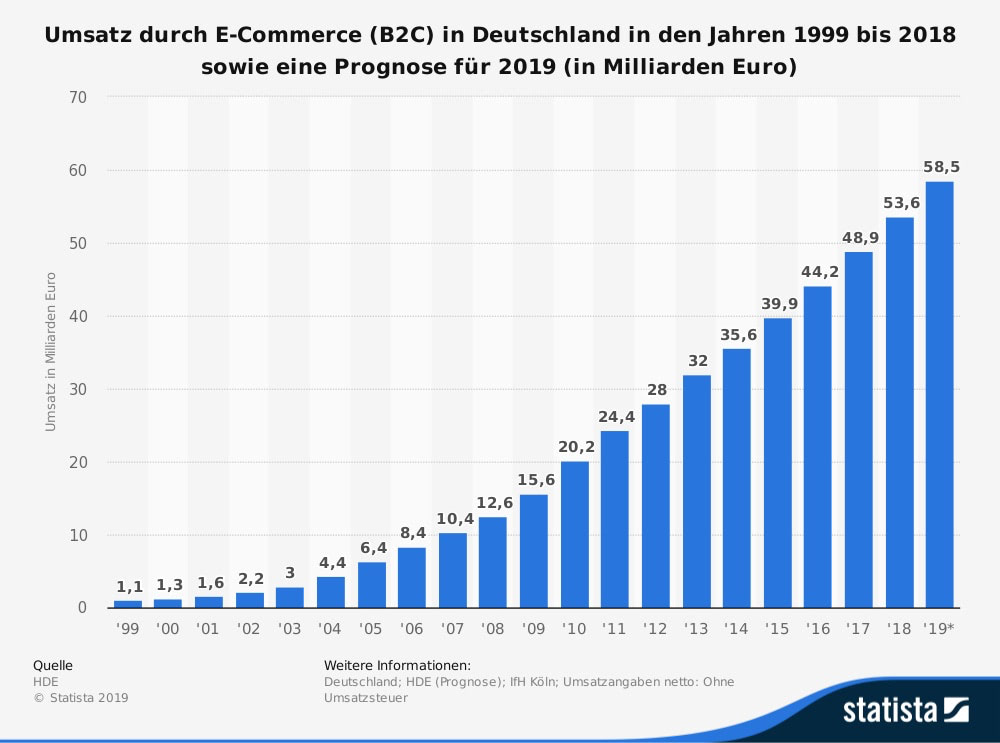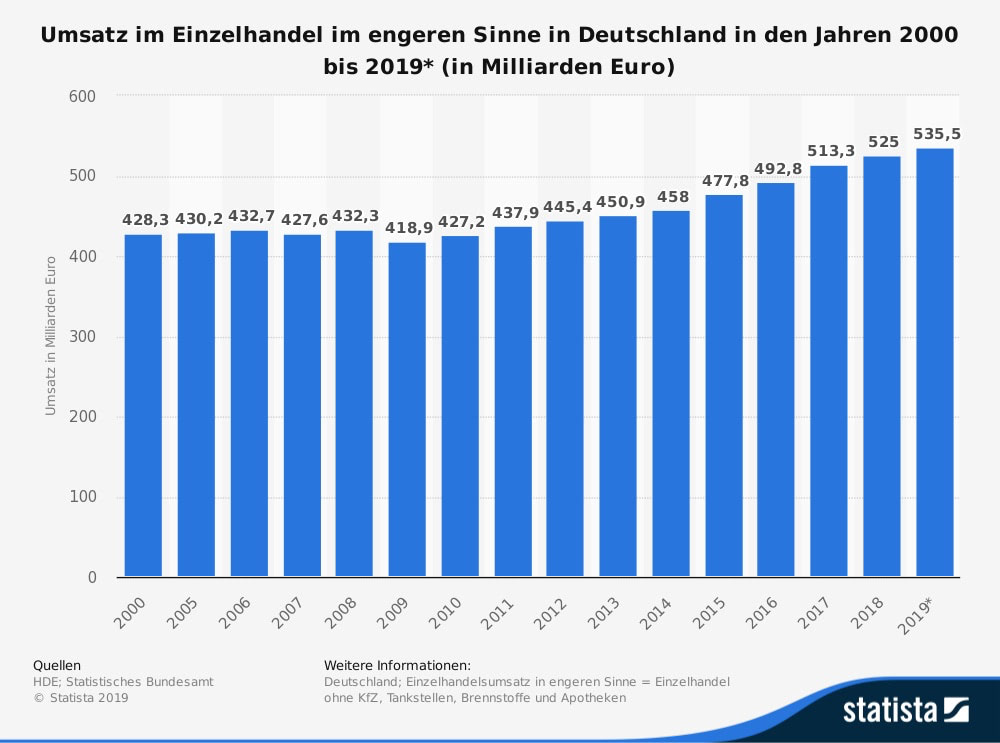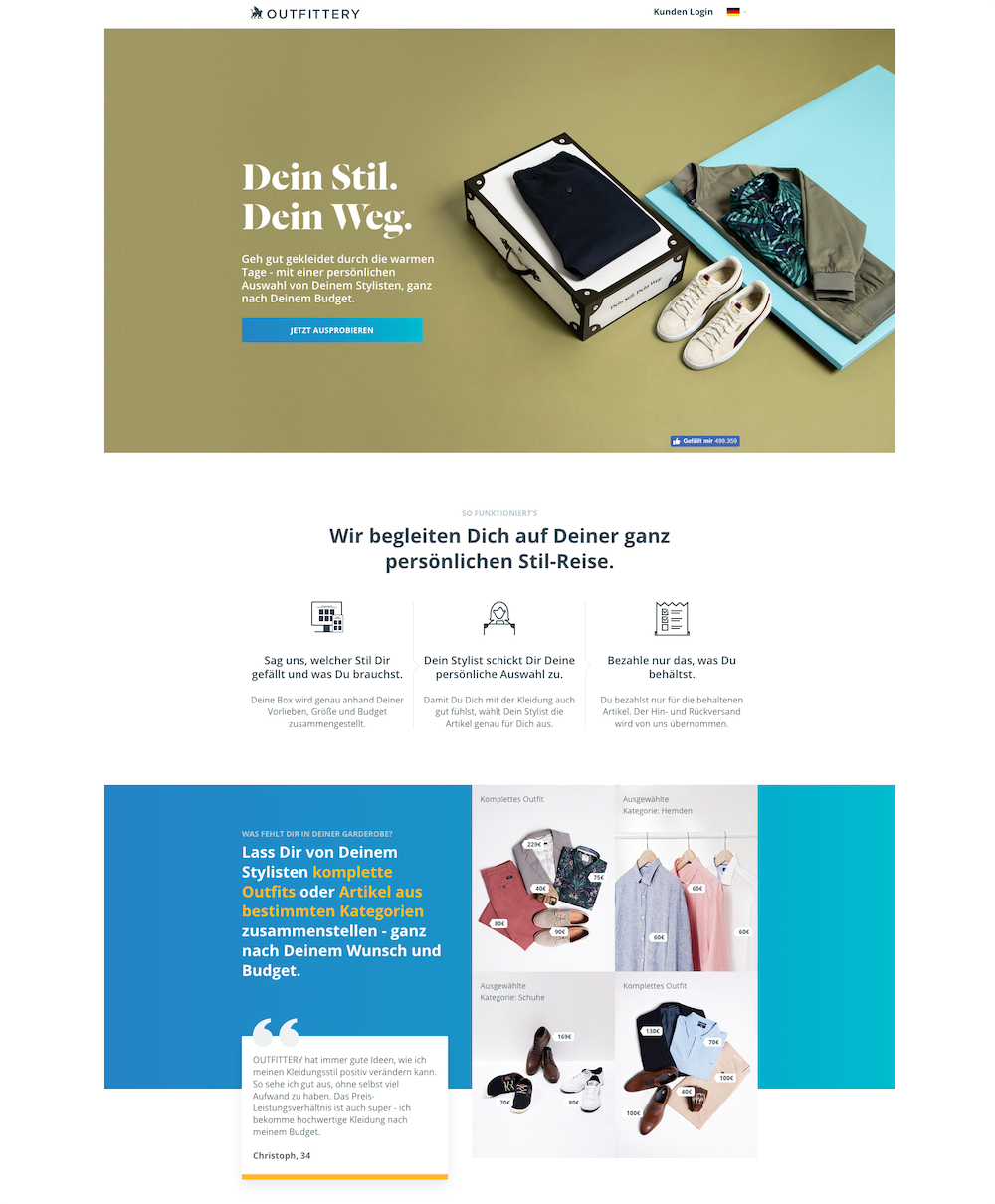Online trade and stationary trade – how retailers can combine the two

They are very much opposites and, above all, great competitors: Online retail and brick-and-mortar retail. Online retail in particular seems to want to do harm to brick-and-mortar stores. Convenient, fast and simple – that’s what makes online retailing particularly attractive. Almost everyone has ordered something online. At least that’s the case with the younger generation. But is that a reason to say stationary retail is dead, or are there perhaps even ways to combine the two?
Online and brick-and-mortar retail in figures
It’s no secret that online retail is growing rapidly. If you compare the years 2012 and 2018, sales have almost doubled. While in 2012 sales were still around 28 billion euros, they were in 2018already53.6 billion. Although you may not believe it, retail sales have also increased. Compared to online, however, the growth is nowhere near as strong. In2012, retail sales reached 445.4 billion euros. Compare this to 2018, where sales reached 525 billion euros.
 In the sales of online trade shows a sharply rising curve. (Source: Statista)
In the sales of online trade shows a sharply rising curve. (Source: Statista)
 Compared to online trade, sales in stationary trade increased only very slightly. (Source: Statista)
Compared to online trade, sales in stationary trade increased only very slightly. (Source: Statista)
Now you’re probably wondering why there’s always talk of the extinction of retail when sales are rising after all. The problem is the low growth. While online competitors are growing at a high rate, brick-and-mortar retail is only growing very moderately. So the fear is that online retail could eventually catch up with or even overtake brick-and-mortar retail.
Rivalry need not be
Stationary retail still takes up a far larger share than online competition. Above all, groceries, cosmetics and furniture are for the most part bought directly in the store. Here, Germans remain loyal to the “old-fashioned” variant. The situation is different for clothes, books and electronics. These items are bought conveniently online. But even if brick-and-mortar retail is not having an easy time of it at the moment, that doesn’t mean it’s out of the running. Online retailing and stationary retailing can certainly be combined. Retailers have various options for this:
Multichannel
Retailers use different channels for the sale of their goods. For example, they have a brick-and-mortar store and at the same time operate an online store, sell their products via a catalog or other online marketplaces such as eBay and Amazon. In this way, the online market no longer becomes a direct competitor. Indeed, revenues can be generated through all channels. A trade without online presence promises only limited success these days. That’s why many major fashion retailers have already implemented multichannel. H&M, Zara, Mango and Co. have long operated an online store. H&M also offers the option of ordering via a catalog.
Crosschannel
Many online stores offer crosschannel. Crosschannel describes an extension of multichannel. Here, “click and collect” and “order in store” are combined. Customers can, on the one hand, order items in the online store and have the package delivered to a store of the same name and pick it up there. The other option is to order items in the store and have them delivered to their home.
The advantages: With “click and collect,” customers can order from the comfort of their sofa and still benefit from the retail service. For example, the items can be tried on directly in the store. Anything that doesn’t fit can be exchanged right there in the store. With “Order in Store”, the customer receives advice in the store and can then have the items delivered to their home and try them on there at their leisure. Crosschannel makes it very easy to combine online and stationary retail. Hunkemöller offers its customers Click & Collect, for example. This saves them the shipping costs.
 At Hunkemöller, customers can reserve items in the store and then pick them up. (Source: Hunkemöller)
At Hunkemöller, customers can reserve items in the store and then pick them up. (Source: Hunkemöller)
Curated Shopping
This alternative combines the convenience of online shopping with the expert advice of brick-and-mortar retail. The customer must first fill out a questionnaire. Here he provides information about his fashion tastes. Do they prefer dressy clothes or a more casual look? He can also state what he doesn’t like at all. After the stylist knows the customer’s favorite brands, age and expectations, a package is put together that is tailored directly to him. This usually includes several outfits, from which the customer can keep those that meet his expectations. Curated shopping, however, requires experts who would otherwise be employed in brick-and-mortar retail – a win-win situation, so to speak. Another advantage of this variant is that stores can save themselves the usually high rents for retail space in city centers. With curated shopping, the company Outfittery has developed a successful offering just for men.
 At Outfittery, style consultants put together outfits for customers. (Source: Outfittery)
At Outfittery, style consultants put together outfits for customers. (Source: Outfittery)
Advantages and disadvantages
.
Of course, online retail and brick-and-mortar retail have their strengths and weaknesses. For some customers, online retail offers the better overall package for others the stationary. Which advantages customers place more value on is up to them.
Advantages online trade
-
- It can be shopped from anywhere (from the sofa, from the train and on the road)
- No pre-set opening hours
-
- Find the cheapest offer through direct price comparison
-
- Larger item selection
- Advantage for retailers: through ordering customers they can create personalized advertising
.
Advantages stationary trade
-
- Direct contact with products
- Salespeople can help with questions immediately
- Social event: interact with salespeople or go shopping with friends
-
- Faster and hassle-free returns and payments
- No shipping costs
- No minimum order value
Conclusion
It turns out that the fear for retail is not entirely unfounded. Sales are growing much slower than online retail. If this growth remains at the same level, it may well be that online retail will dominate in the future. However, it would still take a while before that would be the case. However, with integrations such as cross-channel, multichannel and curated shopping, opportunities have been created that can successfully combine online and stationary retail. This brings advantages for both online retail and brick-and-mortar retail. What’s more, it probably wouldn’t work entirely without retail.



